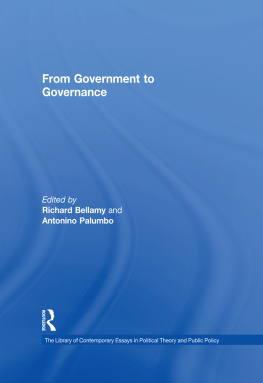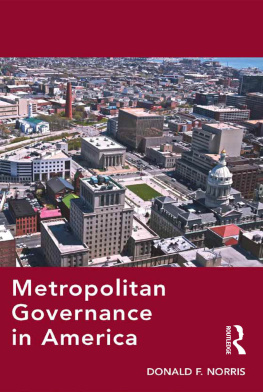Salamon Lester M. - The tools of government: a guide to the new governance
Here you can read online Salamon Lester M. - The tools of government: a guide to the new governance full text of the book (entire story) in english for free. Download pdf and epub, get meaning, cover and reviews about this ebook. City: New York;N.Y;Oxford, year: 2002, publisher: Oxford University Press, Incorporated, genre: Politics. Description of the work, (preface) as well as reviews are available. Best literature library LitArk.com created for fans of good reading and offers a wide selection of genres:
Romance novel
Science fiction
Adventure
Detective
Science
History
Home and family
Prose
Art
Politics
Computer
Non-fiction
Religion
Business
Children
Humor
Choose a favorite category and find really read worthwhile books. Enjoy immersion in the world of imagination, feel the emotions of the characters or learn something new for yourself, make an fascinating discovery.

- Book:The tools of government: a guide to the new governance
- Author:
- Publisher:Oxford University Press, Incorporated
- Genre:
- Year:2002
- City:New York;N.Y;Oxford
- Rating:4 / 5
- Favourites:Add to favourites
- Your mark:
- 80
- 1
- 2
- 3
- 4
- 5
The tools of government: a guide to the new governance: summary, description and annotation
We offer to read an annotation, description, summary or preface (depends on what the author of the book "The tools of government: a guide to the new governance" wrote himself). If you haven't found the necessary information about the book — write in the comments, we will try to find it.
The tools of government: a guide to the new governance — read online for free the complete book (whole text) full work
Below is the text of the book, divided by pages. System saving the place of the last page read, allows you to conveniently read the book "The tools of government: a guide to the new governance" online for free, without having to search again every time where you left off. Put a bookmark, and you can go to the page where you finished reading at any time.
Font size:
Interval:
Bookmark:
THE TOOLS OF GOVERNMENT
A Guide to the New Governance
Edited by
Lester M. Salamon
With the special assistance of
Odus V. Elliott


Oxford New York
Athens Auckland Bangkok Bogot Buenos Aires Calcutta
Cape Town Chennai Dar es Salaam Delhi Florence Hong Kong Istanbul
Karachi Kuala Lumpur Madrid Melbourne Mexico City Mumbai
Nairobi Paris So Paulo Shanghai Singapore Taipei Tokyo Toronto Warsaw
and associated companies in
Berlin Ibadan
Copyright 2002 by Lester M. Salamon
Published by Oxford University Press, Inc.
198 Madison Avenue, New York, New York 10016
www.oup.com
Oxford is a registered trademark of Oxford University Press
All rights reserved. No part of this publication may be reproduced,
stored in a retrieval system, or transmitted, in any form or by any means,
electronic, mechanical, photocopying, recording, or otherwise,
without the prior permission of Oxford University Press.
Library of Congress Cataloging-in-Publication Data
The tools of government : a guide to the new governance / edited by Lester M. Salamon ;
with the special assistance of Odus V. Elliott,
p. cm.
Includes bibliographical references and index.
ISBN 0-19-513665-9 (acid-free paper)
1. Political planning. 2. Public administration. 3. Intergovernmental cooperation. 4.
Public-private sector cooperation. 5. Contracting out. I. Salamon, Lester M. II. Elliott,
Odus V.
JP1525.P6T662001 351dc21 2001032134
1 3 5 7 9 8 6 4 2
Printed in the United States of America
on acid-free paper
Lester M. Salamon
Christopher K. Leman
Thomas H. Stanton and Ronald C. Moe
Lester M. Salamon
Peter J. May
Ron J. Feldman
Janet A. Weiss
Joseph J. Cordes
Steven J. Kelman
Ruth Hoogland DeHoog and Lester M. Salamon
David R. Beam and Timothy J. Conlan
Thomas H. Stanton
Christopher Howard
C. Eugene Steuerle and Eric C. Twombly
Peter H. Schuck
Donald F. Kettl
John J. Lordan
Paul L. Posner
B. Guy Peters
Steven Rathgeb Smith and Helen Ingram
Arthur B. Ringeling
Lester M. Salamon
A political dispute has been raging throughout the world for at least the last two decades over the relative effectiveness of government and private action, and of different levels of government, in addressing public needs.
Largely overlooked in this dispute, however, has been the extent to which actual public problem solving has come to embrace the collaborative actions of governments at multiple levels and both government and private institutions. The vehicle for this has been the development and widespread adoption of a host of alternative instruments of public action through which governments at different levels and private organizationsboth for-profit and nonprofithave joined forces to meet human needs. Included here are grants, contracts, insurance, regulation, loan guarantees, vouchers, corrective fees, and tax expenditures. Taken together, these instruments have altered public management in rather fundamental ways, severing the financing of government action from the delivery of public services and creating complex networks that merge the activities of national and local governments and public and private organizations in increasingly inventive ways. Unfortunately, however, neither the training of public managers nor the popular discourse about government operations has yet come fully to terms with the resulting transformation.
It was this realization that led me, along with a handful of other analysts, to call more than two decades ago for the development of a more systematic body of knowledge about the varied tools of public action in widespread use, and about the system of third-party government to which they had given rise. Since then, considerable headway fortunately has been made in formulating such a tools approach and creating the base of knowledge required to put it into effect. At the same time, the proliferation and utilization of tools have clearly outpaced the formulation and dissemination of knowledge about their characteristics and demands. What is more, the deep ideological divide between supporters and opponents of state action has continued to foster a rhetoric that obscures the extent to which public and private action have fused. As a consequence, practitioners, policymakers, and the general public alike still find themselves ill equipped to cope with the challenges that public problem solving now entails.
This book is designed to take a major step toward filling this gap. It represents the most comprehensive effort yet attempted to pull together in one place a systematic description of the major tools now being used to address public problems both in the United States and, increasingly, around the world; to identify the major tasks that each of these tools entails, the circumstances for which each is best suited, and the kinds of challenges that each involves; and to examine the most important crosscutting issues that many of these tools pose. More than that, the book formulates a framework for coming to terms with the very different style of public problem solving that these different tools have made possible. Called the new governance, this framework emphasizes the collaborative nature of modern efforts to meet human needs, the widespread use of tools of action that engage complex networks of public and private actors, and the resulting need for a different style of public management, and a different type of public sector, emphasizing collaboration and enablement rather than hierarchy and control.
While I am responsible for whatever shortcomings this volume may exhibit, numerous individuals and organizations share responsibility for any merits it may have. First and foremost is Dr. Paul Posner of the U.S. General Accounting Office, who first encouraged me to update and expand my earlier book on this topic, Beyond Privatization: The Tools of Government Action, which was published by the Urban Institute Press in 1989. Dr. Robert Long and the W. K. Kellogg Foundation, for which he works, saw the connection between this work and the broader initiative that Kellogg was launching in the area of nonprofit management and provided generous financial support that enabled this project to proceed. Scott Fosler, then of the National Academy of Public Administration; Dr. Richard Nathan of the State University of New York at Albany; Jonathan Breul, of the U.S. Office of Management and Budget; Melissa Middleton of the University of Minnesota; and former governor Michael Dukakis of Massachusetts agreed to serve on an advisory committee to oversee the project and assist me in identifying collaborating authors. An outstanding group of analysts familiar with the various tools of public action, although not always with the tools concept, then agreed to prepare chapters on the different tools or on a variety of crosscutting themes that many of the newer tools have posed, and to take part in what turned out to be an extended pro-seminar on the nature, character, and implications of various tools conducted over more than a two-year period via e-mail, memorandum, and in-person meetings as drafts were developed, reviewed, and revised. Christopher Collins and his colleagues at Oxford University Press had the vision to understand the promise of the resulting product when it was still a glimmer in its creators eye and to stand by the project through its extended gestation and development. Finally, helping me keep track of all this activity and ensure that the entire effort kept moving was Dr. Odus V. Elliott, a research associate of the johns Hopkins Institute for Policy Studies. To all of them I owe my deepest gratitude.
Next pageFont size:
Interval:
Bookmark:
Similar books «The tools of government: a guide to the new governance»
Look at similar books to The tools of government: a guide to the new governance. We have selected literature similar in name and meaning in the hope of providing readers with more options to find new, interesting, not yet read works.
Discussion, reviews of the book The tools of government: a guide to the new governance and just readers' own opinions. Leave your comments, write what you think about the work, its meaning or the main characters. Specify what exactly you liked and what you didn't like, and why you think so.











